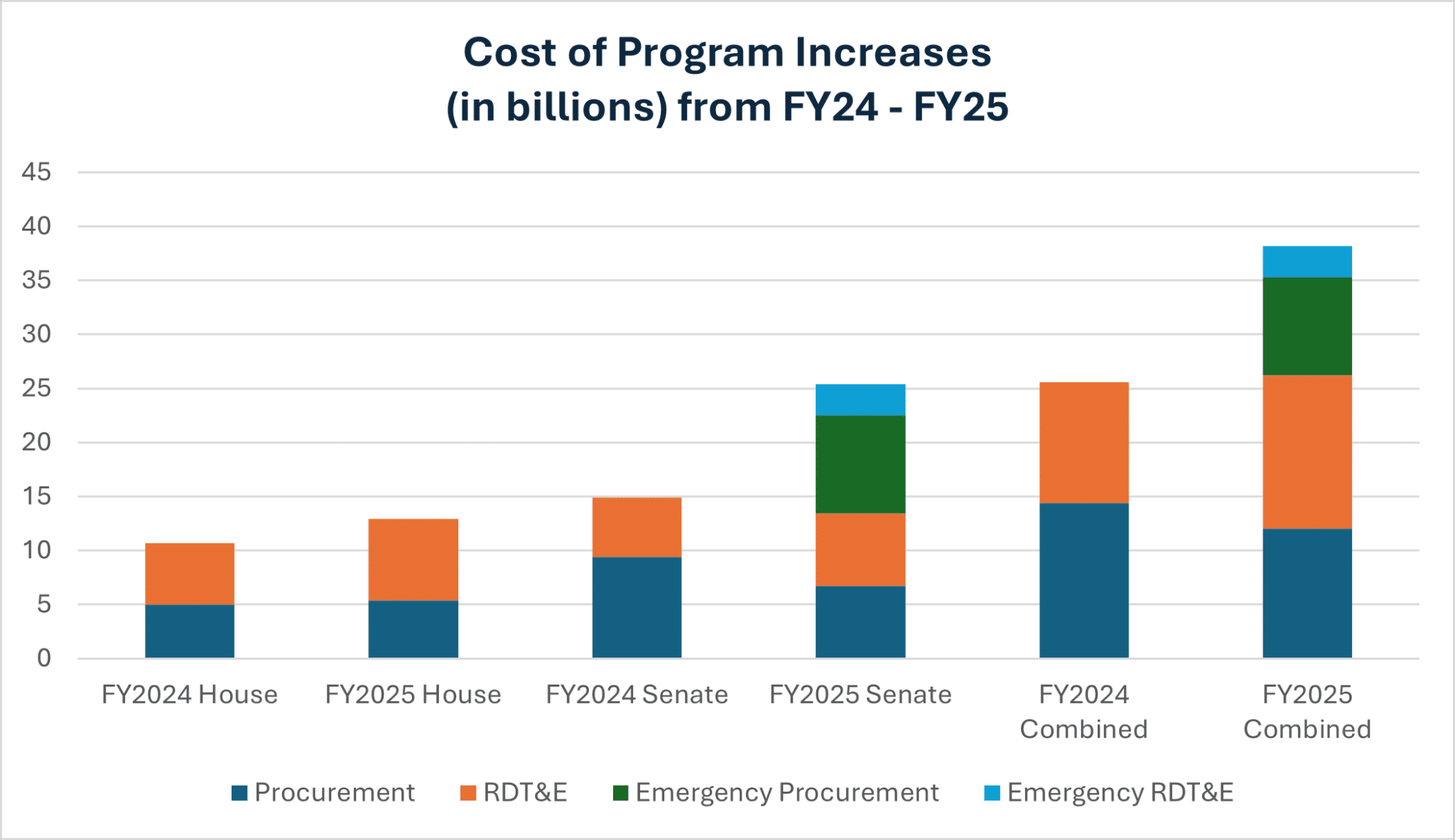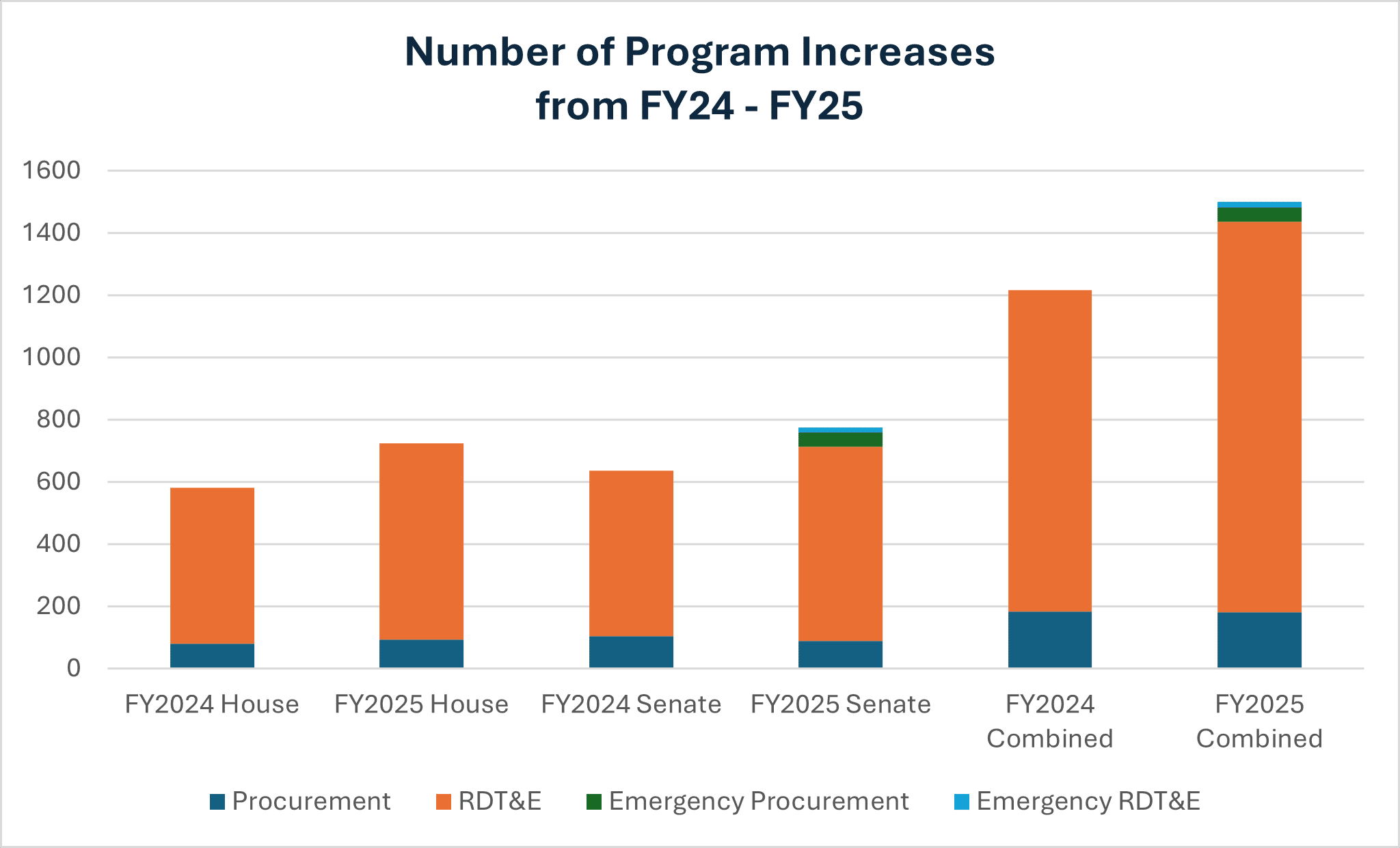In the fine print of the Fiscal Year 2025 House and Senate Defense Appropriations bills, which have yet to be conferenced, passed, and signed into law, lawmakers have proposed 1,500 individual program increases for the Pentagon’s Procurement and Research, Development, Test, and Evaluation (RDT&E) accounts, totaling over $39 billion. That’s up from 1,216 program increases included in the House and Senate FY2024 bills—totaling over $25 billion. Of the FY2025 increases, $12 billion is categorized as “emergency” spending in the Senate bill, but even excluding this, the data shows a steady growth in congressional program increases.
While program increases aren’t technically defined as earmarks by Congress, they operate in a similar way. The main differences are that program increases, at least in theory, are competitively awarded, and come with virtually no transparency or justification requirements. The Pentagon’s budget request includes thousands of pages of budget justification documents complete with rationales for each program and detailed future-year spending plans, but congressional program increases generally don’t include justifications or long-term cost projections. Most don’t even list who sponsored them.
After it was repeatedly exposed that lawmakers were using earmarks to funnel money into their states and districts with little transparency and accountability, Congress enacted transparency measures, enabling taxpayers to see which lawmakers are requesting earmarks and for what purpose. Taxpayers for Common Sense has built an Earmarks Database, revealing over $15 billion in earmark requests in FY2024, and thanks to these transparency measures, our database can show which lawmakers requested specific earmarks. This is still short of full transparency – TCS shouldn’t have to create a database when Congress could easily create its own, and earmarks still don’t require thorough justifications like those found in the administration’s budget justification documents.
However, even the underwhelming level of transparency afforded to earmarks does not exist for congressional program increases in our recently updated Congressional Pentagon Budget Increases Database, even though they cost more than double all of the earmarks in FY2024.
This needs to change. Congress should require at least the same transparency and justification for program increases that they demand for formal earmarks. A closer examination of questionable increases makes the case for greater transparency even more compelling.
Increases Over Last Year
It’s important to remember that the FY2025 Defense Appropriations Act has not yet been finalized. Both the House and Senate have their versions, which will be reconciled through conferencing before a final bill is sent to the President. For now, our comparisons between FY2024 and FY2025 are based on program increases in the House-passed and Senate Appropriations Committee-passed versions of the bills, the most recent versions of both.
Also, our FY2025 numbers include emergency spending, while FY2024’s do not. This discrepancy exists because FY2024 emergency Pentagon spending was passed through a separate supplemental bill. In contrast, the FY2025 Senate bill includes $21 billion in emergency funding, of which $12 billion is for the Pentagon’s Procurement and RDT&E accounts.
The chart below compares the cost of program increases in the House and Senate bills for FY2024 and FY2025, with further breakdowns for procurement and RDT&E funding, as well as emergency funding. It also shows the combined cost of increases in the House and Senate bills, though these figures do not perfectly reflect the final costs, which were slightly lower for FY2024 and are not yet available for FY2025.
As the chart shows, even without emergency spending, lawmakers proposed slightly more spending (5.5 percent) on Procurement and RDT&E program increases combined in FY2025 than they did in FY2024, totaling about $27.1 billion. When you include emergency spending, lawmakers proposed far more spending (52.5 percent) for FY2025 compared to FY2024, for a total of about $39.1 billion.
Interestingly, looking at the number of increases rather than their cost, as shown in the chart below, reveals a different story.
Through this lens, we can see that emergency spending increases made up a relatively modest percentage of the total number of increases—about 4 percent. Excluding emergency increases, the data shows a nearly 2 percent decrease in the number of procurement increases, while RDT&E increases rose by nearly 22 percent. When combined, the total number of procurement and RDT&E increases rose by about 18 percent without emergency spending and 23 percent when including it.
TCS has long criticized the misuse of emergency funding mechanisms to cover non-emergency expenses. This year, lawmakers explicitly stated that some of the funding in the Pentagon appropriations bill was labeled as “emergency” in order to circumvent budget caps agreed to last year. While some emergency funding in this bill may have addressed genuinely unforeseen events, much of it does not. The most striking example is the 16 “emergency” RDT&E increases, totaling $2.9 billion, including $500 million for the Navy’s next generation fighter, which won’t be operational until the 2030s at the earliest.
Emergency spending aside, a 5.5 percent jump in the cost and an 18 percent jump in the number of proposed increases tells us the practice of lawmakers seeking program increases to the Pentagon budget is very much on the rise.
Zero to Hero
Another dataset we track is the number and cost of program increases for projects that received no funding in the Pentagon’s budget request, what we call “Zero to Hero” increases. By cross-referencing each program increase against the Pentagon’s budget justification books, we can draw interesting conclusions about how Congress allocates additional funds to the Pentagon’s budget.
Zero to Hero increases accounted for 30 percent of the total cost of program increases for procurement and RDT&E in FY2025, compared to 59 percent in FY2024. This discrepancy can largely be attributed to the fact that most emergency spending went to projects already funded in the Pentagon’s budget request. Non-emergency Zero to Hero increases accounted for 44 percent of the total cost of non-emergency increases in FY2025. Regardless, there was a clear decline in the cost of Zero to Hero increases compared to last year, whether emergency spending is included or not.
Looking at the number of Zero to Hero increases rather than the cost changes the picture again. While their total cost decreased from $15.1 billion in FY2024 to $14.1 billion in FY2025, the number of Zero to Hero increases rose from 1,014 to 1,082, reflecting an overall rise in the number of program increases this year.
Still, Zero to Hero increases as a percentage of the total number of increases dropped this year. Including emergency increases, Zero to Hero increases accounted for 72 percent of the total number of procurement and RDT&E increases in FY2025, or 74 percent when excluding emergency increases, down from 83 percent in FY2024.
This relative decrease in Zero to Hero increases is a positive development in what is otherwise a troubling trend in congressional program increases to the Pentagon budget. However, the fact that nearly three-quarters of these increases for procurement and RDT&E are for projects that received no funding in the Pentagon’s budget request underscores the heavy influence of Pentagon contractors in shaping congressional spending decisions.
Unfunded Priorities
Since FY2017, Congress has required the military service branches and combatant commands to submit so-called “unfunded priority lists” (UPLs) to Congress—essentially wish lists of service leaders and commanders that weren’t included in the Pentagon’s budget request. We’ve long opposed these lists, as they contribute to wasteful Pentagon spending and, like congressional program increases in general, don’t require the same level of budget justification and long-term cost assessments as the formal budget request. As Pentagon Comptroller Mike McCord put it in 2023, “having multiple individual senior leaders submit priorities for additional funding absent the benefit of weighing costs and benefits across the department is not an effective way to illuminate our top joint priorities.”
Unfortunately, these lists are only growing. So far, lawmakers have proposed at least 34 program increases for procurement and RDT&E in the House and Senate Pentagon spending bills for FY2025 that appear to respond to the Pentagon’s FY2025 UPLs, with a total cost of over $5 billion. Given the lack of transparency around UPLs (the lists aren’t classified, but they’re not widely publicized either) and the often-cryptic descriptions of program increases, the true number and cost of these increases may be higher.
While UPLs only make up a small proportion of the overall number (2.3 percent) and cost (13 percent) of congressional program increases for procurement and RDT&E, they represent a significant amount of funding for projects the Pentagon couldn’t find room for in its $850 billion budget request.
Funding Offsets
The House and Senate have proposed a combined $39 billion in program increases for procurement and RDT&E in their FY2025 Pentagon spending bills, but that doesn’t mean they’re proposing a net $39 billion increase to the Pentagon’s budget. Most of the non-emergency funding, around $27.1 billion, was offset by cutting funds from elsewhere in the Pentagon’s budget request. Some cuts, such as proposed cuts to the F-35 program due to its ongoing production challenges and persistently low mission-capable rate, are warranted. However, funding cuts could become savings instead of being redirected into other projects. It’s also difficult to assess which cuts are justified when most program increases don’t specify their offsets.
Only program increases introduced as amendments list their sponsors and offsets. So far, 149 program increases for procurement and RDT&E offered as amendments have been approved on the House floor, with another amendment increase agreed to in the Senate Appropriations Committee. All these amendments passed en bloc by voice vote, indicating little controversy.
While listing sponsors and offsets in amendments for program increases is helpful, the fact that Congress adopted $1.3 billion in program increases with no debate or recorded votes suggests a troubling apathy among lawmakers when it comes to scrutinizing their own additions to the Pentagon budget.
Moreover, if the offsets listed for amendment-based increases reflect the overall trend, there is concern that many of these increases are being funded by cutting from the Pentagon’s Operation & Maintenance (O&M) accounts—essential for maintaining military readiness.
Of the 150 program increases for procurement and RDT&E approved as amendments, 70 (about 47 percent) were offset by cutting funds from O&M. That represents $604 million (46 percent) of the $1.3 billion added through amendments, essentially “raiding” O&M.
Repeat Offenders
Our April 2024 report on FY2024 congressional program increases highlighted several that seemed to benefit lawmakers’ districts or campaign contributors. The FY2025 Pentagon spending bills repeat many of those same increases.
In March 2024, Sen. Gary Peters (D-MI) took credit for securing $4.2 million in the FY2024 spending bill for Stryker Driver-Assistance Systems, an upgrade for the Stryker family of armored vehicles. In a press release, he said that the funds would “help ensure that Made in Michigan ground vehicles like the Strykers are operating with cutting edge technology designed to keep our servicemembers safe.”
Less than five months later, he took credit for securing $3 million in the FY2025 spending bill for the same systems, echoing his previous argument that the funds would “help ensure that Made in Michigan ground vehicles like the Strykers are operating with cutting edge technology designed to keep our servicemembers safe.”
These vehicles are manufactured by General Dynamics Land Systems-Canada, a subsidiary of General Dynamics. According to Open Secrets, a nonpartisan, independent nonprofit tracking money in politics, General Dynamics’ PAC and individuals associated with the company have contributed $71,187 to Sen. Peters’ campaign committee and leadership PAC since 2019.
Similarly, Sen. Cindy Hyde-Smith (R-MS) took credit for a $25 million program increase in the FY2024 bill for “advanced composite shaft design,” under the Columbia-class ballistic missile submarine program. This increase was mentioned in a press release detailing “Work involving Mississippi universities and defense firms as part of Defense Department modernization initiatives.” The FY2025 bill also includes a $2 million program increase for “advanced composite shaft design.”
The only Mississippi company that’s received Pentagon contracts for advanced composites in the past is Seemann Composites, LLC. Since the start of Sen. Hyde-Smith’s Senate career in 2017, individuals associated with Seemann Composites have contributed $86,800 to her campaign, making it her top source of campaign contributions.
Other Questionable Increases
In a press release highlighting “Shaheen-secured priorities in the Department of Defense Appropriations Act for Fiscal Year 2025,” under the subheading “Continued Investments in New Hampshire’s Aerospace and Defense Industry,” Sen. Jeanne Shaheen (D-NH) celebrated that “the bill fully funds work done in Londonderry on L3 Harris’s Enhanced Night Vision Goggle-Binocular.” The Senate’s Pentagon spending bill includes a program increase of $10 million for “ENVG-B advanced capabilities.” Since 2019, L3Harris Technologies’ PAC and individuals associated with the company have contributed $48,345 to Sen. Shaheen’s campaign committee and leadership PAC.
Rep. Tony Gonzales (R-TX) claimed credit in a press release for securing $15 million in the Pentagon spending bill “for Air Force vertical integration of scramjet supply chain… to continue the development of a vertically integrated facility housing an entire supply chain in a single location to accelerate the research, development, and production of hypersonic propulsion systems/airbreathing hypersonic engines.” The release notes that “The Southwest Research Institute in San Antonio specializes in this area of military innovation,” suggesting the congressman views Southwest Research Institute (SwRI) as a likely recipient of these funds.
Although SwRI is a nonprofit, its President and CEO Adam Hamilton was paid over $1.4 million in 2021. This year, SwRI has paid $160,000 in lobbying fees to Akin Gump Strauss Hauer & Feld LLP. Akin Gump’s PAC and individuals associated with the firm have contributed $11,703 to Rep. Gonzales’ campaign in the 2024 election cycle.
Conclusion
Each election cycle, the military industry contributes tens of millions of dollars to lawmakers to curry favor and ensure a receptive audience when seeking meetings. As Congress begins work on the Pentagon budget, the hundreds of millions of dollars Pentagon contractors spend each cycle on lobbying manifests as an army of lobbyists descending on Capitol Hill. They target members, particularly those on the armed services and appropriations committees who receive a disproportionate share of the industry’s campaign contributions, to secure program increases to the Pentagon budget.
Data from our updated Congressional Pentagon Budget Increases Database shows that these tactics are successful. This should concern anyone who values fiscal responsibility and national security. Pentagon spending is on track to hit $1 trillion annually sooner rather than later, while the Congressional Budget Office (CBO) estimates that for the first time, interest payments on the national debt will exceed military spending this year. The Pentagon budget is a major driver of that debt, which means strong oversight and fiscal restraint are essential for national security.
However, while Congress conducts oversight and sometimes exercises restraint in reviewing the Pentagon’s budget request, it does not apply the same scrutiny to its own additions to the Pentagon budget.
Congress must address this by implementing transparency measures that allow the public to easily identify sponsors of program increases (and earmarks) online in a downloadable, searchable, and sortable format. We also urge Congress to require sponsors of program increases to provide justifications and long-term cost assessments for each increase and make this information publicly available on their website. Finally, within one year of the enactment of the Pentagon spending bill’s enactment, sponsors should list the recipients of contracts for their enacted program increases on their website and clarify whether those contracts were awarded competitively.
This post has been updated to account for one program increase that was erroneously excluded from our previous calculations on the number and cost of program increases.













Get Social